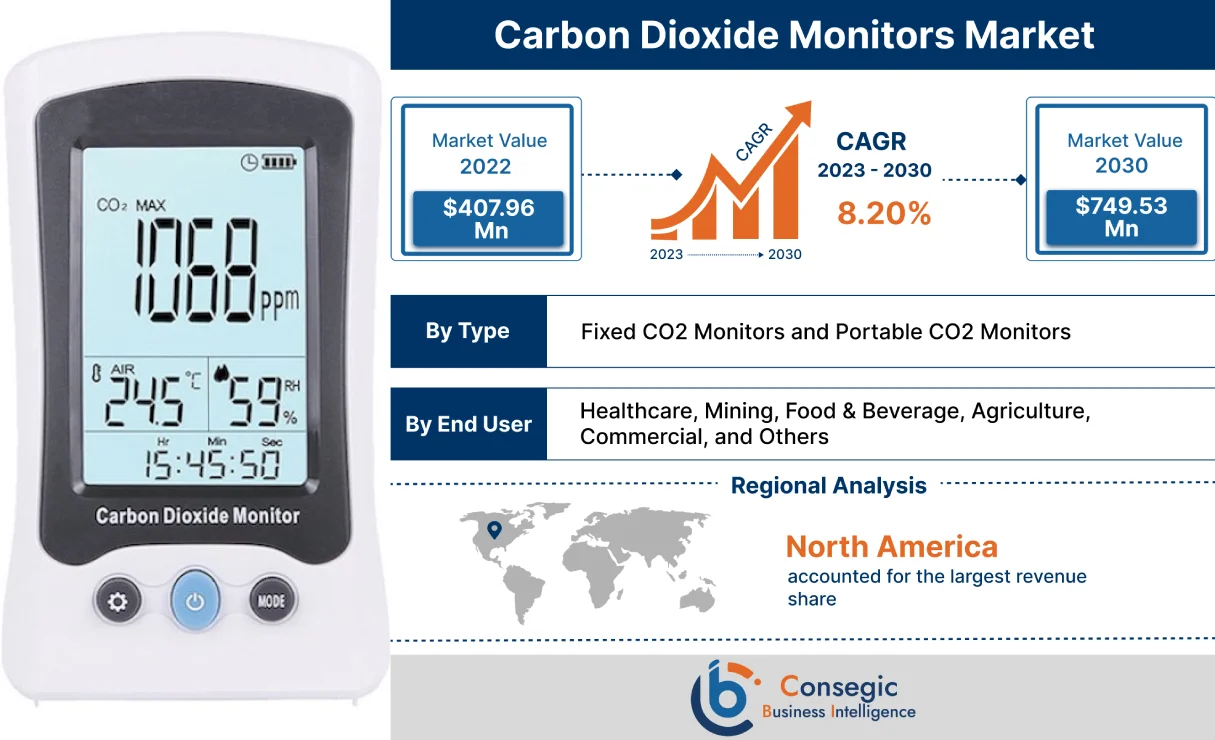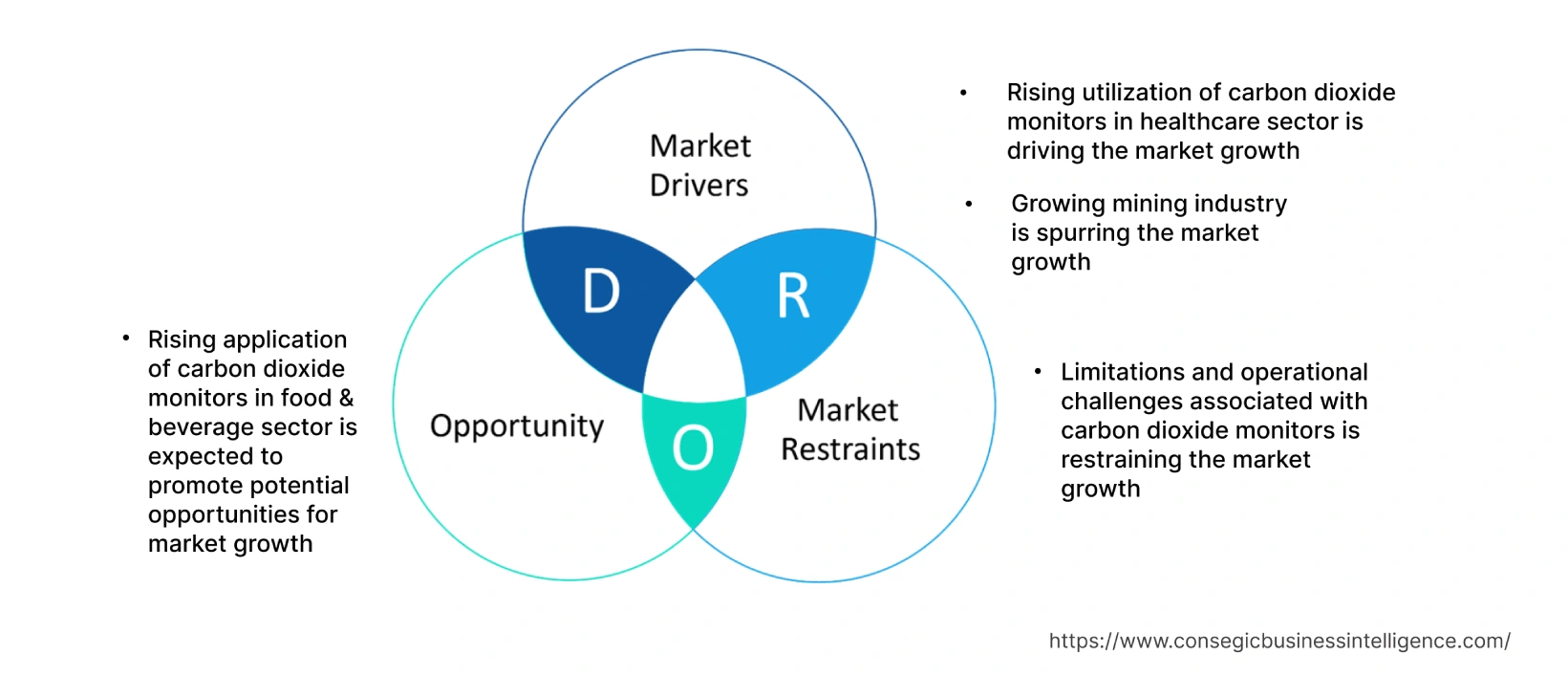- Summary
- Table Of Content
- Methodology
Carbon Dioxide Monitors Market Size :
Carbon Dioxide Monitors Market is estimated to reach over USD 749.53 Million by 2030 from a value of USD 407.96 Million in 2022, growing at a CAGR of 8.20% from 2023 to 2030.
Carbon Dioxide Monitors Market Scope & Overview:
Carbon dioxide monitors refer to an instrument designed for measuring carbon dioxide gas in an industrial or commercial setting. Carbon dioxide monitors help in identifying any areas of poor ventilation, which enables users to make necessary changes to ensure proper and safe ventilation within a particular space. Moreover, carbon dioxide monitors offer a range of benefits including reduced risks of viruses, identification of concentration of other air pollutants, discovery of HVAC system inefficiencies, prevention of high levels of carbon dioxide exposure, and others. The aforementioned benefits of carbon dioxide monitors are key determinants for increasing its deployment in healthcare, mining, food & beverage, agriculture, commercial, and other industries.
Carbon Dioxide Monitors Market Insights :
Key Drivers :
Rising utilization of carbon dioxide monitors in healthcare sector is driving the market growth
Carbon dioxide monitors are primarily used in healthcare sector, particularly in hospitals and clinics for application in patient monitoring and management. Carbon dioxide monitors are capable of providing mainstream or side stream carbon dioxide monitoring for intubated and non-intubated patients. Additionally, the utilization of carbon dioxide monitors in healthcare facilities enable advanced CO2 monitoring, which enables healthcare professionals to leverage the information for minimizing the duration of mechanical ventilation and optimizing the potential for successful extubation while managing critically ill patients. The above features of carbon dioxide monitors are prime aspects for increasing its utilization in healthcare sector.
Factors including the growth trend in healthcare expenditure, expansion of hospitals and healthcare facilities, increasing number of patient admissions in hospitals, and rising demand for advanced patient monitoring solutions in healthcare facilities are among the key prospects driving the adoption of carbon dioxide monitors.
For instance, in March 2022, Cleveland Clinic inaugurated its new Cleveland Clinic London Hospital in the United Kingdom. The hospital is equipped with a full range of medical and comprehensive services including equipment for imaging and interventional radiology, along with laser and robotic surgery capabilities. Thus, the expansion of hospitals and healthcare facilities are increasing the adoption of carbon dioxide monitors for its application in patient monitoring and management to ensure proper ventilation and respiratory performance, in turn driving the growth of the market.
Growing mining industry is spurring the market growth
Carbon dioxide monitors are used in the mining industry for measurement of carbon dioxide emissions in mines to ensure a safe operational environment. Carbon dioxide emissions occur during a spontaneous heating event in a mine, and it is a crucial gas to monitor for detection of impulsive heating at an early stage to prevent any hazard. Carbon dioxide monitors are primarily used for monitoring carbon dioxide levels in mines to ensure safe operations for underground managers, safety representatives, ventilation managers, and workers operating on mining sites.
Factors including the rising demand for metals and minerals, increasing mining projects, and growing need for efficient gas monitoring solutions for preventing health hazards in mining sites are driving the growth of the mining industry.
For instance, in June 2022, Talison Lithium Pty Ltd commenced operations in the Greenbushes lithium mine expansion project located in Western Australia with initial investment of approximately USD 202 million. The expansion project aims at expanding the area of the mine and upgrading the existing ore facilities. The processing capacity for the complete project is estimated to increase up to 9.5MM ton per year from 4.7MM ton per year. Hence, increasing mining activity is increasing the adoption of carbon dioxide monitors for measurement of carbon dioxide emissions in mines to ensure safe operational environment, in turn proliferating the market growth.
Key Restraints :
Limitations and operational challenges associated with carbon dioxide monitors is restraining the market growth
The utilization of carbon dioxide monitors is usually associated with few limitations and operational challenges, which is a key factor limiting the market growth.
For instance, the measurements of carbon dioxide monitors are often affected by temperature and humidity. Similarly, the presence of other substances in the air generates inaccurate readings in carbon dioxide monitors, in turn hampering its performance.
Additionally, few of the other limitations associated with carbon dioxide monitors include shorter life span, prone to aging, and inaccurate measurements in presence of other gases in the air. Therefore, the aforementioned limitations and operational challenges associated with carbon dioxide monitors are constraining the growth of the market.
Future Opportunities :
Rising application of carbon dioxide monitors in food & beverage sector is expected to promote potential opportunities for market growth
The rising application of carbon dioxide monitors in the food & beverage sector is expected to present potential opportunities for the growth of the carbon dioxide monitors market. Carbon dioxide monitors are utilized for monitoring of carbon dioxide in food processing facilities to ensure operational safety and long life of equipment in various applications including bottling of carbonated beverages, fermentation facilities, along with detection and elimination of refrigerator leakage in cold rooms. Moreover, the deployment of carbon dioxide monitors in food & beverage production facilities enable informed decision making to provide sustainable food production, storage, and logistics among others.
Factors including rising investments in the food & beverage sector, increasing consumer demand for packaged and processed food products, and growing demand for aerated drinks are key prospects driving the growth of the food & beverage industry.
For instance, according to Food Drink Europe, a European Union confederation for the food industry, the food and beverage industry in the European Union region was valued at EUR 1,121 billion (USD 1,292.0 billion) in 2022, witnessing an incline of 2.6% in comparison to EUR 1,093 billion (USD 1,177.8 billion) in 2021. Therefore, the growth of food & beverage sector is anticipated to increase the application of carbon dioxide monitors for aforementioned applications, in turn promoting opportunities for market growth during the forecast period.
Carbon Dioxide Monitors Market Report Insights :
| Report Attributes | Report Details |
| Study Timeline | 2017-2030 |
| Market Size in 2030 | USD 749.53 Million |
| CAGR (2023-2030) | 8.20% |
| By Type | Fixed CO2 Monitors and Portable CO2 Monitors |
| By End-User | Healthcare, Mining, Food & Beverage, Agriculture, Commercial, and Others |
| By Region | North America, Europe, Asia-Pacific, Latin America, and Middle East & Africa |
| Key Players | Criticare Technologies Inc., Masimo, Koninklijke Philips N.V, Medtronic, Shenzhen Mindray Bio-Medical Electronics Co. Ltd, Nihon Kohden Corporation, Nonin, GE Healthcare, OSI Systems Inc., Radiometer Medical ApS, Thames Medical Ltd. |
Carbon Dioxide Monitors Market Segmental Analysis :
By Type :
Based on the type, the market is bifurcated into fixed CO2 monitors and portable CO2 monitors. The fixed CO2 monitors segment accounted for the largest revenue share in the year 2022. Fixed CO2 monitors are installed in inflammable and explosive places for testing and continuous monitoring of carbon dioxide levels. Moreover, fixed CO2 monitors are often installed on steel structures in industrial facilities and a cable connects the monitor to a supervisory control and data acquisition system for continuous monitoring. Moreover, fixed CO2 monitors enable remote viewing of the measurement data, which further reduces the occurrence of dangerous accidents and ensures the safety of the property. Additionally, fixed CO2 monitors are ideal for application in food & beverage, healthcare, agriculture, and commercial sectors among others.
In March 2019, HORIBA Ltd. launched its APCA-370 carbon dioxide monitor that is designed for use in combination with an air quality monitoring system and other systems for industrial applications. APCA-370 carbon dioxide monitor is optimized to meet the growing demand for monitoring of CO2 concentrations in the indoor environment, enhanced monitoring of greenhouse gases, and leakage detection of CO2 during the collection/storage processes. Hence, rising innovation associated with fixed CO2 monitors is among the key factors contributing to the growth of the market.
The portable CO2 monitors segment is anticipated to register fastest CAGR growth during the forecast period. Portable CO2 monitors are handheld devices that are mainly designed to be carried or clipped to an item of clothing as a part of a personnel's PPE (Personal protective equipment). Portable CO2 monitors are often battery-operated and transfer warnings through visible and audible signals such as flashlights and alarms when high and unsafe levels of carbon dioxide gas are detected. Moreover, portable CO2 monitors offer several benefits including compact size, ease of deployment, live gas readings, and direct protection of individuals, which makes it ideal for application in mining sites, food & beverage processing facilities, hospitals, and others.
For instance, in January 2021, International Gas Detectors launched its new iGAS personal CO2 monitor. The CO2 monitor is designed to be compact, reliable, and affordable solution for portable carbon dioxide detection and monitoring for applications including hospitals, laboratories, food & beverage facilities, and others. Therefore, the rising development of portable carbon dioxide monitors for industrial applications to ensure worker's safety is anticipated to drive the market growth during the forecast period.
By End-User :
Based on the end-user, the market is segregated into healthcare, mining, food & beverage, agriculture, commercial, and others. The healthcare segment accounted for the largest revenue share of 35.6% in the year 2022. Factors including the growing trend in healthcare expenditure, rising development of hospitals and clinics, increasing demand for advanced patient monitoring solutions in healthcare facilities are driving the growth of the healthcare segment.
For instance, in May 2022, the UPMC Hillman Cancer Centre located in Sicily, Italy commenced its commercial operations. The healthcare facility enables the healthcare professionals to provide medical oncology services that supplement the hospital's surgical capabilities, along with a specific focus on cardiothoracic and gastrointestinal and cancers. Therefore, the expansion of healthcare facilities is driving the adoption of carbon dioxide monitors for its utilization in patient monitoring and management to ensure proper ventilation and respiratory performance, in turn proliferating the growth of the market.
Mining segment is expected to witness fastest CAGR growth during the forecast period. The growth of mining segment is attributed to several factors including growing demand for metals and minerals, rising mining projects, and increasing need for gas monitoring solutions for preventing health hazards and ensuring workers safety in mining sites.
For instance, in February 2020, Barrick Gold Corporation and Japan Gold formed a collaboration for exploration, development, and mining of certain gold mineral properties in Japan. Barrick Gold Corporation invested around USD 5.6 million on the initial evaluation phase of the gold mining project by the end of 2021. Carbon dioxide monitors are primarily used for monitoring carbon dioxide levels in mines to ensure safe operations for underground managers, safety representatives, ventilation managers, and workers operating on mining sites. Thus, the rising mining activities is projected to drive the adoption of carbon dioxide monitors, in turn driving the growth of the market during the forecast period.
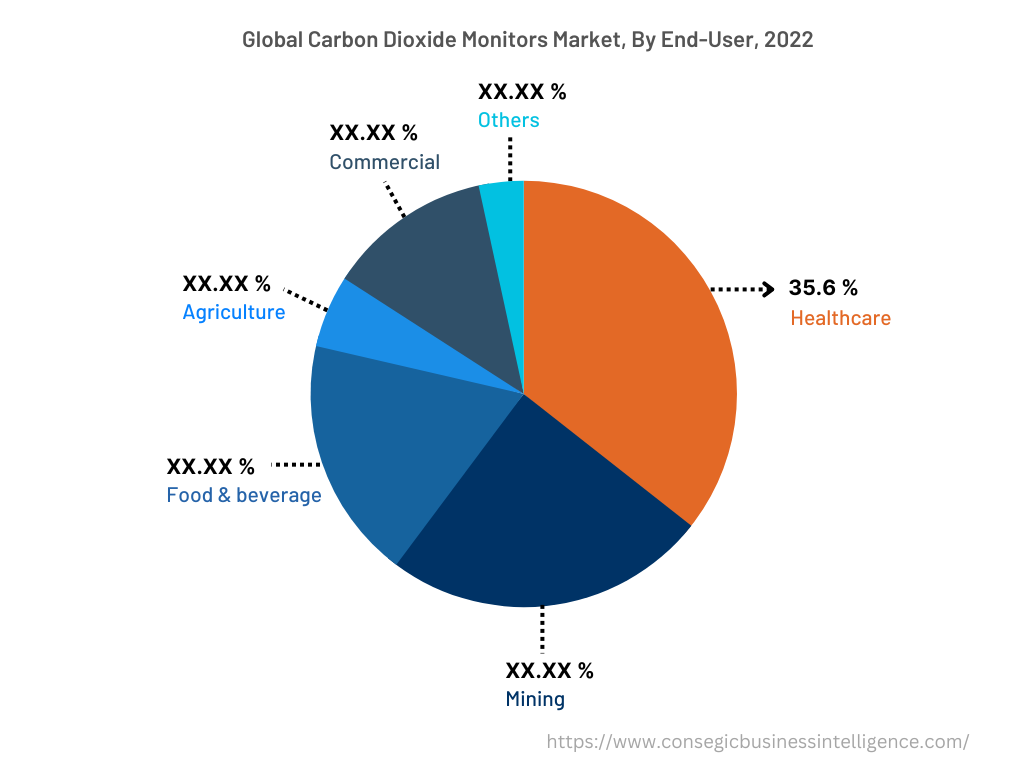
By Region :
The regional segment includes North America, Europe, Asia Pacific, Middle East and Africa, and Latin America.
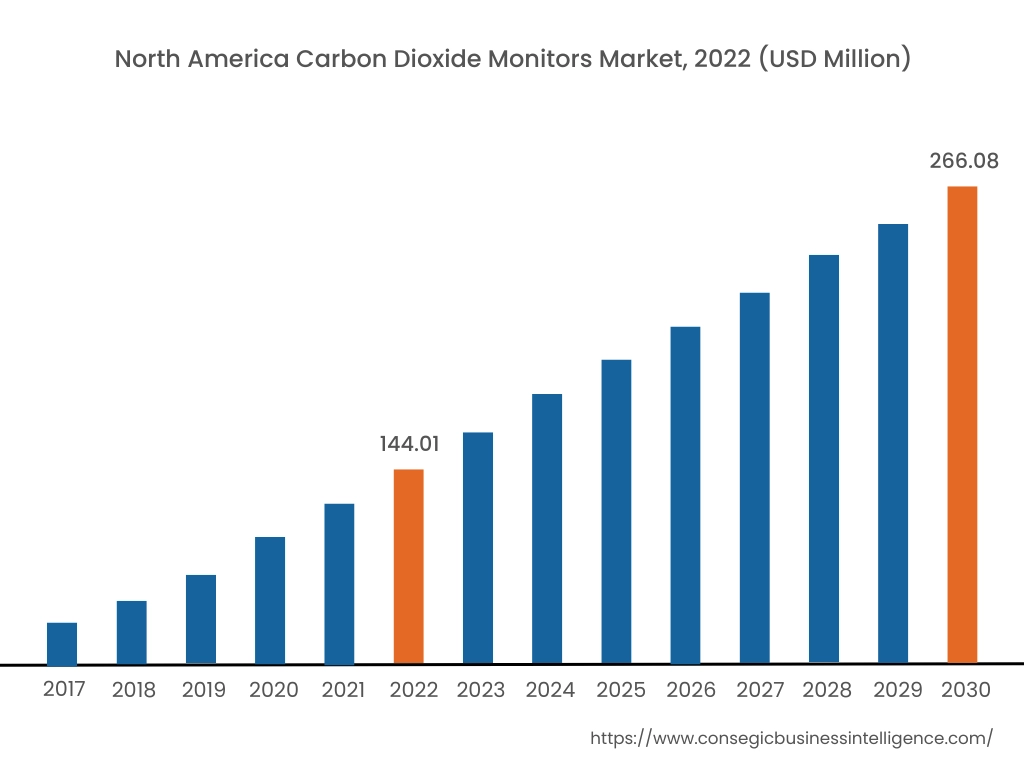
North America accounted for the largest revenue share of USD 144.01 Million in 2022 and is expected to reach USD 266.08 Million by 2030, registering a CAGR of 8.3% during the forecast period. In addition, in the region, the U.S. accounted for the maximum revenue share of 62.6% in the same year. The adoption of carbon dioxide monitors in the North American region is mostly driven by its utilization in food & beverage, healthcare, commercial, and other sectors. Moreover, the increasing utilization of carbon dioxide monitors in food & beverage processing facilities to ensure operational safety in various applications including fermentation facilities, bottling of carbonated beverages, along with detection and elimination of refrigerator leakage in cold rooms is among the significant factors driving the market growth in the region. For instance, in August 2021, Tyson Foods, invested USD 300 million to build a food processing facility in Virginia, U.S. The above factors are further fostering the growth of the carbon dioxide monitors market in the North American region. Additionally, increasing investments in the healthcare and commercial sectors are anticipated to promote lucrative growth aspects for the market in North America during the forecast period.
Asia-Pacific is expected to register fastest CAGR growth of 8.5% during the forecast period. The growing pace of industrialization and development is creating lucrative growth aspects for the market in the region. Moreover, factors including the growth of multiple industries such as healthcare, mining, agriculture, and others are fostering the market growth for carbon dioxide monitors in the Asia-Pacific region.
For instance, according to India Brand Equity Foundation, the Government of India supported the mining sector with the budgetary allocation of approximately USD 117.6 million to the Ministry of Mines for FY20. Additionally, the Indian Government invested USD 236 million for development of 23 mining projects in Madhya Pradesh, India. Hence, the rising investments in the mining sector is anticipated to drive the utilization of carbon dioxide monitors for monitoring carbon dioxide levels in mines to ensure safe operations of workers operating on mining sites, thereby, proliferating the market growth in the Asia-Pacific region during the forecast period.
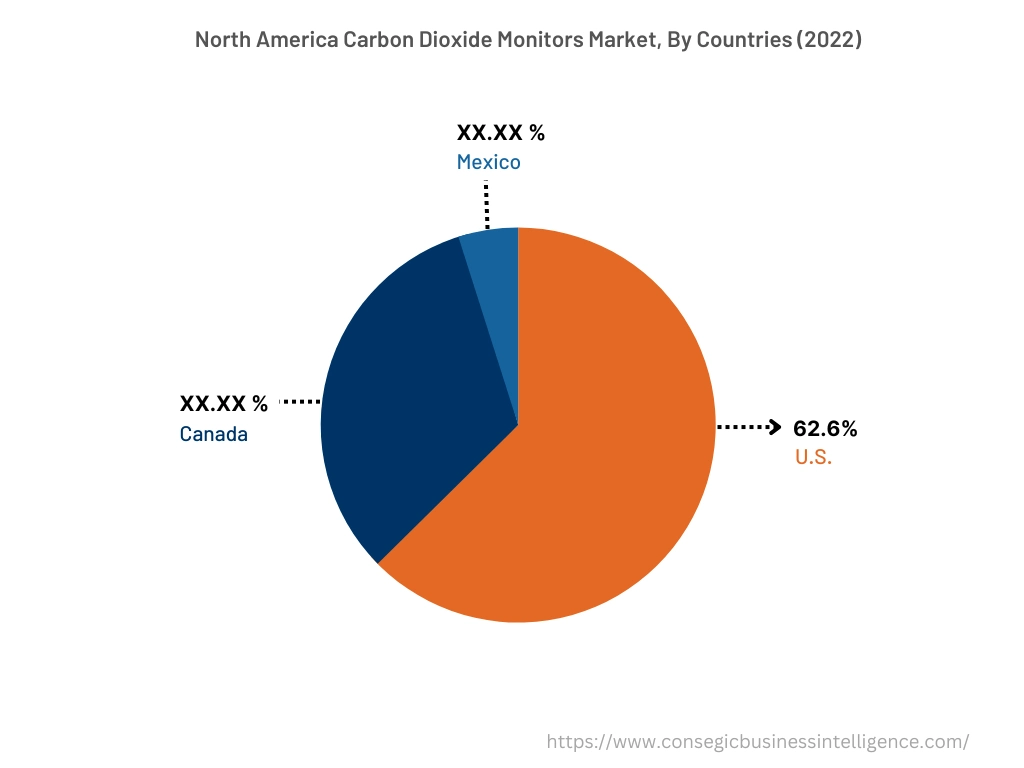
Top Key Players & Market Share Insights:
The carbon dioxide monitors market is highly competitive with major players providing carbon dioxide monitors to the national and international markets. Key players are adopting several strategies in research and development (R&D), product innovation, and application launches to hold a strong position in carbon dioxide monitors market. Key players in the carbon dioxide monitors market include-
- Criticare Technologies Inc.
- Masimo
- OSI Systems Inc.
- Radiometer Medical ApS
- Thames Medical Ltd.
- Koninklijke Philips N.V.
- Medtronic
- Shenzhen Mindray Bio-Medical Electronics Co. Ltd
- Nihon Kohden Corporation
- Nonin
- GE Healthcare
Recent Industry Developments :
- In June 2023, Philips, in collaboration with Masimo, introduced an advanced monitoring abilities to Philips high acuity patient monitors. The extension of Philips and Masimo's collaboration enables the integration of the Masimo's SedLine O3 monitoring module and CO2 advanced measurements into high acuity IntelliVue MX series of multi-parameter monitors from Philips.
Key Questions Answered in the Report
What is carbon dioxide monitors? +
Carbon dioxide monitors refers to an instrument designed for measuring carbon dioxide gas in an industrial or commercial setting.
What specific segmentation details are covered in the carbon dioxide monitors report, and how is the dominating segment impacting the market growth? +
For instance, by type segment has witnessed fixed CO2 monitors as the dominating segment in the year 2022, owing to its increasing utilization in food & beverage, healthcare, agriculture, and commercial sectors among others.
What specific segmentation details are covered in the carbon dioxide monitors market report, and how is the fastest segment anticipated to impact the market growth? +
For instance, by end-user segment has witnessed mining as the fastest-growing segment during the forecast period due to the rising adoption of carbon dioxide monitors for monitoring CO2 levels in mines to ensure safe operations of workers operating on mining sites.
Which region/country is anticipated to witness the highest CAGR during the forecast period, 2023-2030? +
Asia-Pacific is anticipated to register fastest CAGR growth during the forecast period due to rapid pace of industrialization and growth of multiple industries such as healthcare, mining, agriculture, and others.
